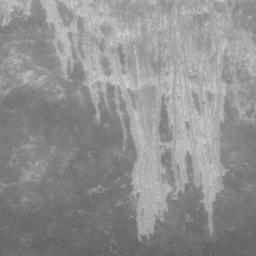
|
Landslides in Marius Crater
- Click the image above for a larger view
- Full-Res JPEG (1000 x 1000) (103.5 kB)
- Full-Res TIFF (1000 x 1000) (1.0 MB)
Caption:
Landslide deposits seen on the steep interior slopes of Marius crater, image is 510 meters wide.
Impact events, volcanism, and tectonism form the majority of features found on the Moon. However landslides are an important modifier of the landscape at small scales. Ultimately, the source of landslides are seismic events triggered by impacts or movements deep inside the Moon. These shaking events cause poorly consolidated material on steep slopes to slide downhill. In this case the slide spreads out in a complex of narrow finger-like streamers. What controls this distinctive pattern? The process is controlled by the energy of the shaking, the size of particles in the slide, the steepness of the slope, and volume of the source deposit. Mars also has many landslide deposits, so scientists are using the new LROC data to compare with these martian counterparts.
Marius crater (41 km diameter) is located in Oceanus Procellarum (11.9°N, 50.8°W) and is notable for its mare-filled floor - unequivocal evidence that it formed before the surrounding mare basalts flooded the region.
Background Info:
NASA's Goddard Space Flight Center built and manages the mission for the Exploration Systems Mission Directorate at NASA Headquarters in Washington. The Lunar Reconnaissance Orbiter Camera was designed to acquire data for landing site certification and to conduct polar illumination studies and global mapping. Operated by Arizona State University, the LROC facility is part of the School of Earth and Space Exploration (SESE). LROC consists of a pair of narrow-angle cameras (NAC) and a single wide-angle camera (WAC). The mission is expected to return over 70 terabytes of image data.
Cataloging Keywords:
| Name | Value | Additional Values |
|---|---|---|
| Target | Moon | Mars |
| System | Earth | |
| Target Type | Satellite | Planet |
| Mission | Lunar Reconnaissance Orbiter (LRO) | |
| Instrument Host | Lunar Reconnaissance Orbiter | |
| Host Type | Orbiter | |
| Instrument | Lunar Reconnaissance Orbiter Camera (NAC) | |
| Detector | Narrow Angle Camera (NAC), Wide Angle Camera (WAC) | |
| Extra Keywords | Crater, Grayscale, Impact, Volcano | |
| Acquisition Date | ||
| Release Date | 2009-11-05 | |
| Date in Caption | ||
| Image Credit | NASA/GSFC/Arizona State University | |
| Source | photojournal.jpl.nasa.gov/catalog/PIA12923 | |
| Identifier | PIA12923 | |
